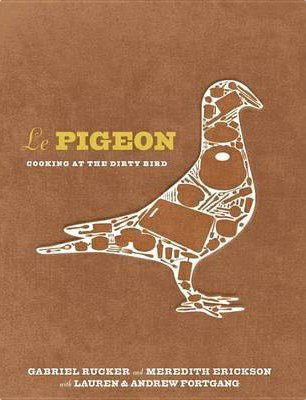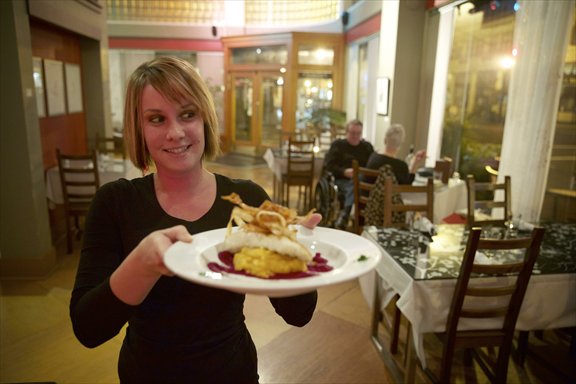Le Pigeon power

Photo: IC

Photo: IC
Chef Gabriel Rucker shares his love for meat in his first cookbook, along with eclectic recipes that have made his Portland, Oregon restaurant, Le Pigeon, a must-go destination for food enthusiasts.
The California-born cook also discusses the ingredients of the northwestern US city that have inspired his French-influenced dishes in Le Pigeon: Cooking at the Dirty Bird, which he co-wrote with his business partner Andrew Fortgang, his wife and pastry chef Lauren Fortgang, and food writer Meredith Erickson.
Rucker, 32, spoke to Reuters about how the Portland dining scene and his favorite meat dishes and ingredients.
Q: What do you want readers to take away from your book?
A: We decided to tell the story of the first five years of the restaurant. It evolved so much and morphed into what it is. You get a breadth of the recipes from the early days like duck nuggets, or "duck, duck, pigeon," or the himachi tartar with truffles or cured foie gras. There are more contemporary recipes like foie gras carpaccio and chanterelle mushroom soup with foie gras candy cap sandwich.
We try to tell a story of a restaurant but also of a place because the community influences so much of what we do here in Portland.
Q: How much has the neighborhood where Le Pigeon is changed?
A: In the neighborhood when we first moved in people were selling heroin in front of the restaurant. Prostitutes were at the corner. But like all things, the place gentrified itself. It's become kind of a destination area.
Q: How has the restaurant changed since you took over?
A: I was only 25 years old when I took over the restaurant. I was still a kid. There was a lot of fire in my pants and I felt anything was possible. I still feel this way. Now there is a certain sense of responsibility. There are many more employees and there is a second restaurant (Little Bird).
Q: What are you experimenting with in the kitchen now?
A: I'm really excited about using Douglas fir. There is a great Oregon distillery Clear Creek. They make a Douglas fir eau de vie (a clear brandy). I was thinking of a cheese course using that. In the spring around late April and May, you could take the tips off of them. I haven't worked with them before.
Q: Your restaurant is known for its offal dishes. What kind of offal and innards are your current favorites?
A: Tuna hearts and tuna marrow are kind of my favorite these days because they are new and they are delicious. When you can get these fresh ahi tuna hearts they have the most intense flavors. You just grill them for a second and you serve them with a bit of salt and lemon juice.
Q: What are your must-have ingredients in the kitchen?
A: Really good vinegar, quality olive oil, European-style butter. Have some black garlic around that's not going to go bad on you. It's a real fun ingredient to spice things up.
Q: What is your favorite food?
A: A cheeseburger.
Carrot Butter-Poached Halibut, Anchovy-Roasted Carrots, Fennel (Serves 4)
▶900 g small carrots, with tops
▶3-1/2 cups (875 g) unsalted butter
▶3 anchovy fillets, minced
▶3 lemons
▶Kosher salt
▶2 cups (500 ml) fresh carrot juice
▶3 cloves garlic, crushed, plus 1 whole clove garlic
▶1 bay leaf
▶Zest of 1 orange
▶1/4 cup (60 ml) extra-virgin olive oil
▶4 halibut fillets, each about 185g
▶Maldon flake salt
▶Fennel Salad
▶1 fennel bulb, sliced 3 mm thick using a mandoline
▶2 tablespoons extra-virgin olive oil
▶2 tablespoons chopped chives
▶1 tablespoon chopped white anchovies (boquerones)
▶Kosher salt & freshly ground black pepper
1. Preheat the oven to 180 C
2. Remove the carrot tops, wash and set aside. Peel the carrots and halve them lengthwise. In a saute pan over medium heat, melt 1/2 cup (125 g) of the butter with the anchovies and the grated zest from the two of the lemons.
Add the carrots and season with kosher salt. Transfer to a baking sheet, spread in a single layer and roast in the oven until slightly softened but still a little crunchy, about 12 minutes. Remove from the oven and toss with the juice of one lemon.
3. In a shallow saute pan over a medium heat, combine the carrot juice, the crushed garlic, bay leaf and orange zest. Cook until reduced by three-quarters, about 10 minutes. Add the remaining 3 cups (750 g) of butter and stir until melted, then reduce the heat to very low and keep warm.
4. Next buzz the carrot top pesto. Simply combine the carrot tops, the whole clove of garlic, the olive oil, the juice of one lemon, and a pinch of kosher salt in a blender and blend until you have a fine pesto consistency. Set aside.
5. To make the fennel salad, in a bowl combine the fennel, olive oil, chives and anchovies and season to taste with salt and pepper. Set aside.
6. Now, to poach the fish. Heat the carrot butter to 55 C over low heat. Season the halibut with kosher salt and add the fish to the butter.
Keeping the butter at 55 C, poach the halibut until you can press down on fish with a fork and don't feel a pop (that pop is connective tissue that hasn't yet broken down), about 10 minutes. Using a slotted spatula, transfer the halibut to a plate lined with paper towels.
Squeeze the juice of the third lemon over the fish and sprinkle with Maldon salt.
7. To serve, place roasted carrots in the center of four shallow bowls and top each with a halibut fillet. Top each halibut fillet with the fennel salad. Drizzle the pesto around the fish, spoon a tablespoon of carrot butter over each plate and serve.